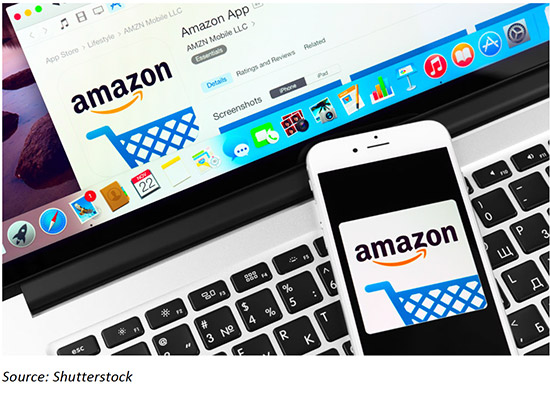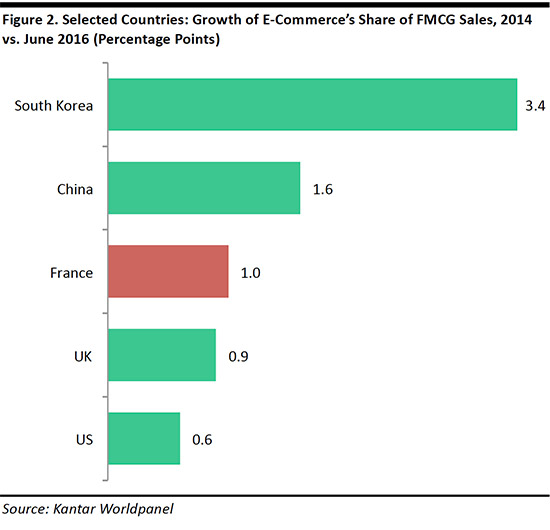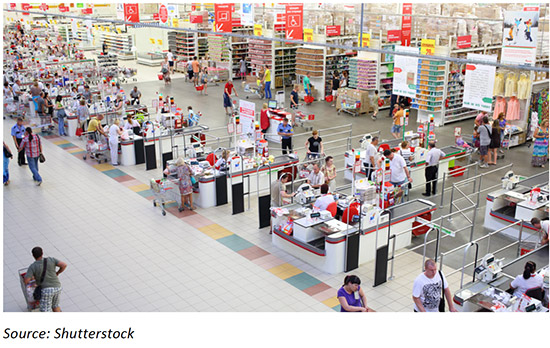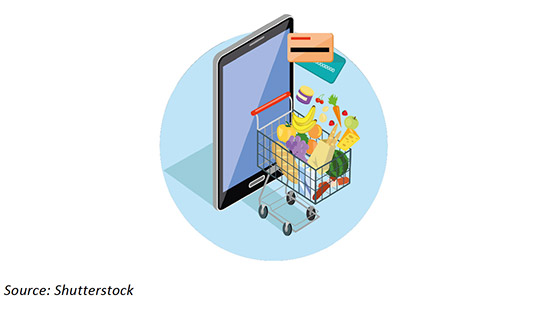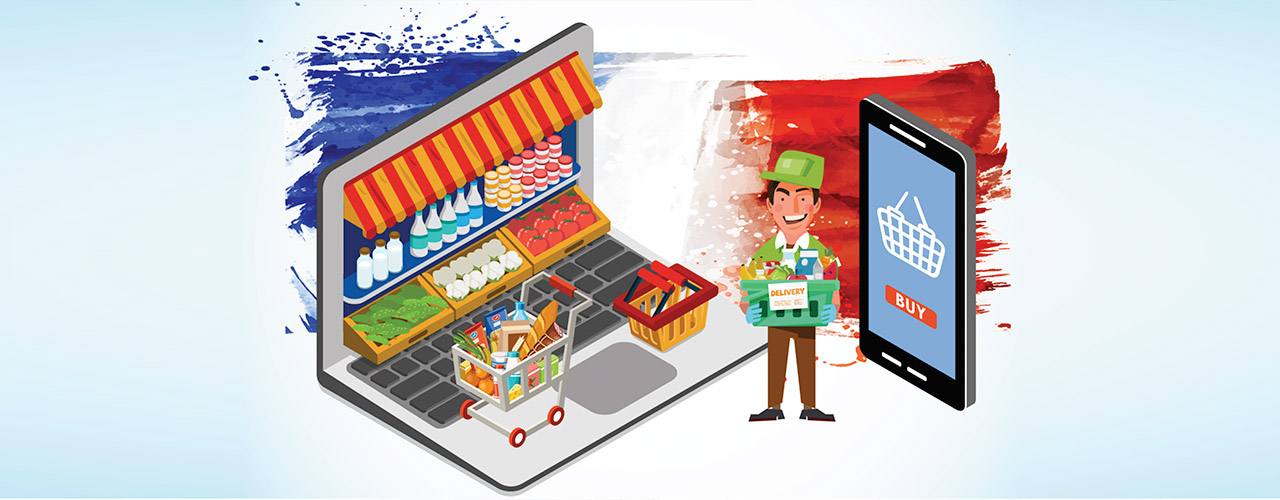
DEEP DIVE: Online Grocery Series: France—Where Click-and-Drive Is King

KEY POINTS
- France has one of the world’s leading online grocery markets. E-commerce accounted for 5.3% of total sales of fast-moving consumer goods (FMCGs) in France as of June 2016, according to Kantar Worldpanel. In Europe, only the UK had a larger share, at 6.9%, while countries such as the US and Germany lagged France considerably.
- The early introduction of drive-through collection services underpinned the expansion of online grocery retailing in France. Some French hypermarket retailers introduced these “click-and-drive” services as early as 2004. The model was successful and expanded rapidly. Our research found that, as of July 2016, there were 3,150 drive-through collection points throughout France. Retailers in other countries introduced click-and-drive at a much later stage.
- Click-and-drive pushed up shopping frequency in France. These services encouraged French consumers who buy groceries online to shop more frequently than consumers in other countries, as French shoppers see click-and-drive as a real alternative to in-store shopping. As a result, France has a larger online grocery retailing market, even though the proportion of consumers buying groceries online in France remains relatively low compared with some other markets.
EXECUTIVE SUMMARY
The French online grocery sector is one of the most advanced in the world: e-commerce’s share of grocery sales in France is the highest in Europe after the UK, according to Kantar Worldpanel. This is the result of the successful application of click-and-drive, a buy-and-collect model, whereby shoppers collect their online grocery purchases at drive-through pickup points located outside grocery stores. The expansion of this model has increased the frequency at which French consumers buy groceries online. At the same time, given the maturity of grocery e-commerce in France, the country sees a relatively low proportion of shoppers buying groceries online.
Our research identified the following key characteristics of the French online grocery market:
- France has one of the world’s leading online grocery markets. As of June 2016, e-commerce accounted for 5.3% of total sales of fast-moving consumer goods (FMCGs) in France, according to research firm Kantar Worldpanel. In Europe, only the UK had a larger share, at 6.9%, while countries such as the US and Germany lagged France considerably.
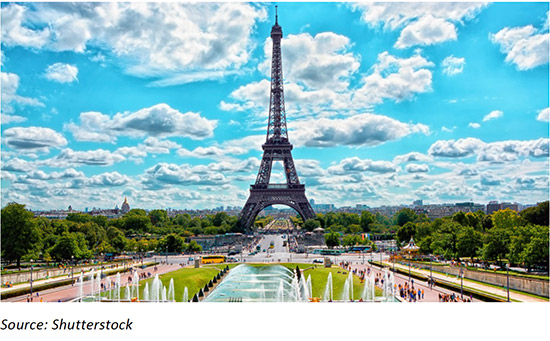
- Online grocery retailing in France expanded rapidly due to the early introduction of click-and-drive. French hypermarket retailers introduced click-and-drive as early as 2004. The model was successful and expanded rapidly. Our research found that, as of July 2016, there were 3,150 drive-through collection points throughout France. Retailers in other countries introduced click-and-drive at a much later stage.
- Click-and-drive pushed up shopping frequency. The expansion of click-and-drive encouraged French consumers who buy groceries online to shop more frequently than consumers in other countries, as French shoppers see click-and-collect as a real alternative to in-store shopping. As a result, France has a larger online grocery retailing market than many other countries, even though the proportion of consumers buying groceries online remains relatively low in France.
INTRODUCTION: FRANCE LAGS IN E-COMMERCE OVERALL, BUT IS A LEADER IN ONLINE GROCERY RETAILING
France is a leading market in grocery e-commerce, even though it lags a number of its European peers in nonfood e-commerce. Only about 12% of nonfood sales in France were made online in 2015, compared with 13.6% in Germany and 21.9% in the UK, according to our analysis of Euromonitor International data. Despite this, France has an advanced online grocery retailing market.
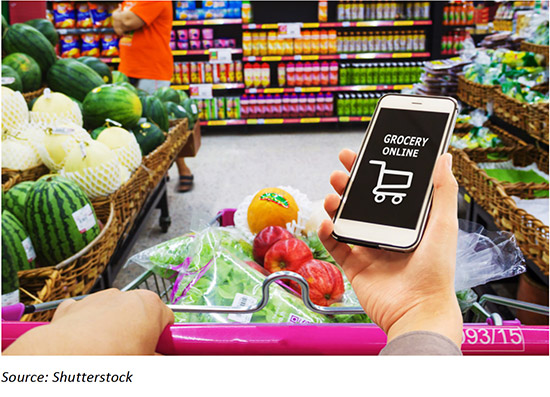
The expansion of grocery e-commerce in France was encouraged by the development of “click-and-drive” services, which allow shoppers to collect their online grocery purchases at drive-through pickup points located outside grocery stores. This fulfillment method complements the hypermarket-led nature of the French grocery sector.
This report provides an overview of the French online grocery market, and shows how the sector is much more developed in France than it is in many other mature grocery markets such as the US and Germany. We illustrate how the click-and-drive model has contributed to the expansion of grocery e-commerce in France and why it is so successful there. Finally, we consider whether the click-and-drive model can be successfully exported to other mature markets that currently have comparatively small online grocery sectors.
We provide a broader overview of the French retail sector, including its e-commerce market, in our report France Retail Overview: Characteristics, Developments and Prospects.
FRANCE IS ONE OF THE WORLD’S LEADING ONLINE GROCERY MARKETS
France is home to one of the largest grocery e-commerce markets in the world. The total value of the French food and drink Internet retailing sector was €4.0 billion in 2015, according to research firm Euromonitor International, second in Europe only to the UK (€8.1 billion) and well ahead of Germany (€1.0 billion).
Euromonitor’s estimates include food and drink products only; they do not consider other products that online grocery retailers might sell, such as household FMCGs or beauty and personal care products. This could explain why other sources are even more optimistic about the size of France’s online grocery sector. UK-based research firm IGD, for example, estimates that the total value of the online grocery retail sector in France was €6.6 billion in 2015.
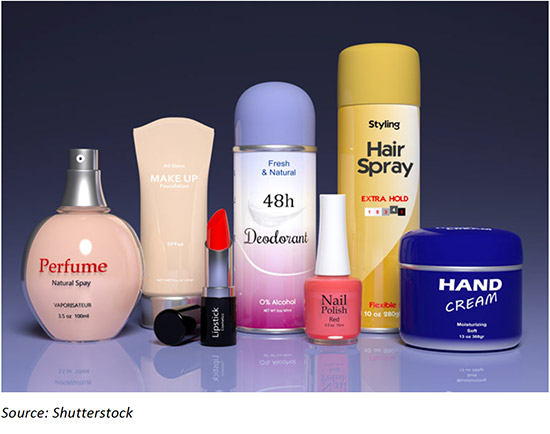
Data from research firm Kantar Worldpanel helps us put the online grocery market in France in the context of overall grocery sales and compare it with those of other major economies. As of June 2016, e-commerce’s share of FMCG sales in France was 5.3%. In Europe, only the UK had a larger share. In Germany, e-commerce’s share of total FMCG sales was less than one quarter of that in France, as shown below.
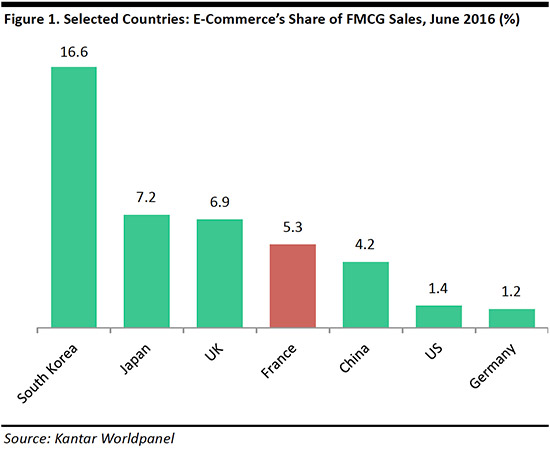
The French online grocery market is also growing fast. According to Kantar Worldpanel, e-commerce’s share of FMCG sales grew faster in France than in any other European country between 2014 and the end of June 2016.
Click-and-Drive: THE EARLY LAUNCH OF A SUCCESSFUL MULTI-CHANNEL MODEL
The early adoption of click-and-drive—a multi-channel model that uses drive-through collection points as pickup facilities for groceries ordered online—has been instrumental in online grocery retailing’s expansion in France. We think that the early introduction of click-and-drive helped grow the market substantially at an early stage.
Supermarket operator Auchan launched its first drive-through service, Auchan Drive, in 2000. While this was not yet a click-and-drive service—Auchan introduced its e-commerce operations only in 2001 with the opening of Auchandirect in the Paris region—the early launch of Auchan Drive shows how firmly rooted the drive-through delivery model is in French grocery retailing. The effective introduction of click-and-drive occurred in 2004, when pure-play grocery retailer Chronodrive, in which Auchan has a majority stake, launched its first dark store from which consumers could collect groceries they had purchased online.
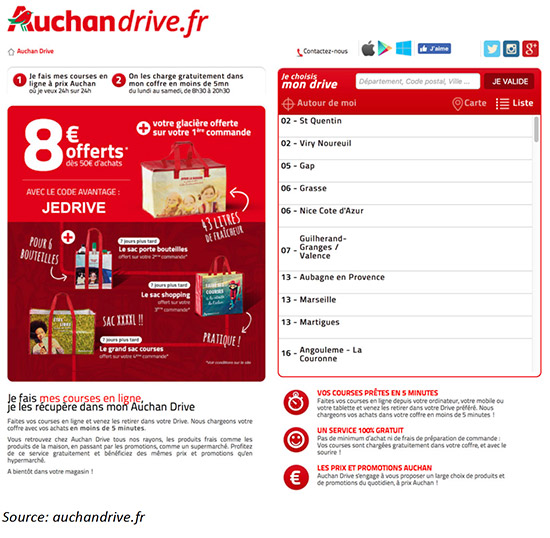
Other major grocery markets saw the adoption of click-and-drive at a much later stage. In the US, for instance, Walmart launched its transactional website in 2000, but it took another seven years for the retailer to introduce a site-to-store service that enabled customers to collect online purchases in-store, and the company started testing an actual click-and-drive model only in 2014.
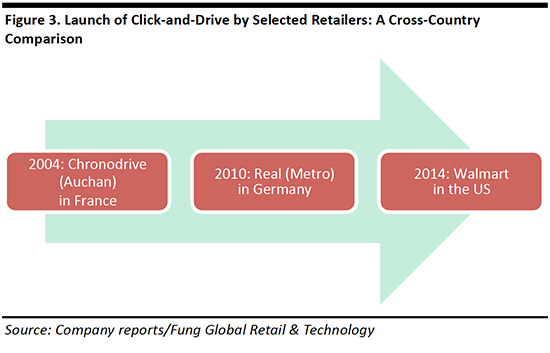
Following Chronodrive’s launch of click-and-drive in 2004, most of the other grocery retailers in France adopted the model and opened drive-through collection points. A rapid expansion of click-and-drive followed.
As of 2013, 80% of the French population already had at least one drive-through grocery collection point within 10 minutes of their home or work address, according to IGD. In March 2014, there were 1,838 drive-through collection points in France, according to Nielsen TradeDimensions. And by July 2016, the number of grocery collection points had reached 3,150, our research found, comfortably exceeding the number of hypermarket outlets in France, which totaled 1,573 in 2015, according to Euromonitor. The table below shows the number of collection points in France, by retailer.
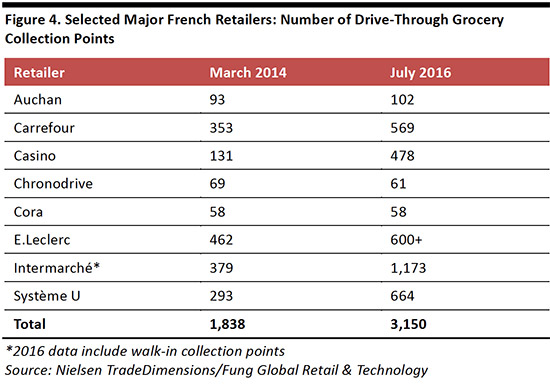
Despite having pioneered the multi-channel model, neither Auchan nor Chronodrive is the leading French grocery retailer in terms of number of collection points: Intermarché had the highest number of collection points as of July 2016, although its number also includes walk-in collection points.
Other retailers that have significantly expanded their drive-through facility numbers include E.Leclerc, Système U and Casino. For E.Leclerc and Système U, click-and-drive is particularly important in terms of total online sales, according to IGD, which estimates that drive-through accounts for most of these two retailers’ online sales growth. In-store collection is another option the companies offer, and Système U also offers home delivery, although E.Leclerc currently does not.
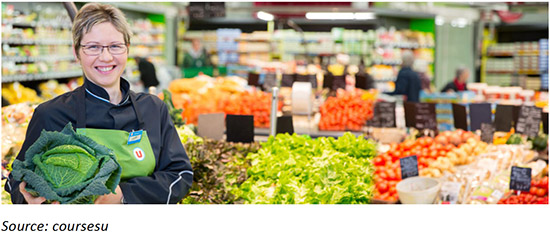
Brick-and-Mortar Retailers Lead Online Grocery Retailing Through Click-and-Drive
Click-and-drive’s role in the expansion of online grocery in France has favored brick-and-mortar retailers. As a result, they dominate online grocery retailing in France. Click-and-drive is so crucial that the sole major Internet pure play in the French market, Chronodrive, operates a click-and-drive model that uses dark stores as collection points. By contrast, Ocado, the only major pure play in the UK online grocery market, focuses on home delivery.
Below, we show an approximate breakdown of online grocery retailers’ market shares in France, based on Kantar Worldpanel figures. These data show that E.Leclerc was the country’s leading online grocery retailer in 2015, and they illustrate how brick-and-mortar players dominate the online channel.
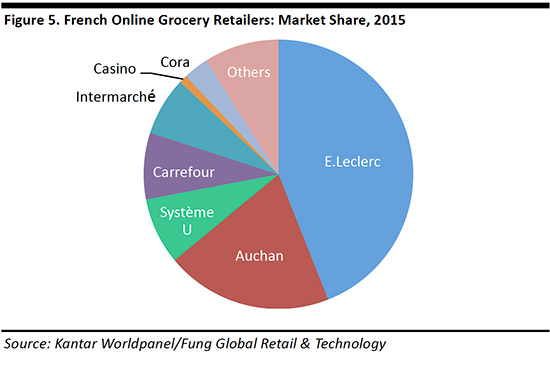
Why the Click-And-Drive Model is Successful in France
The structure of the retail sector in France and the way French consumers shop online are the main reasons the click-and-drive model has been so successful in the country.
A Hypermarket-Led Grocery Sector Favored Click-and-Drive
Click-and-drive makes use of large, well-connected, out-of-town grocery stores. Hypermarkets are more prominent as a grocery retail format in France than they are in other mature markets, as the graph below shows.
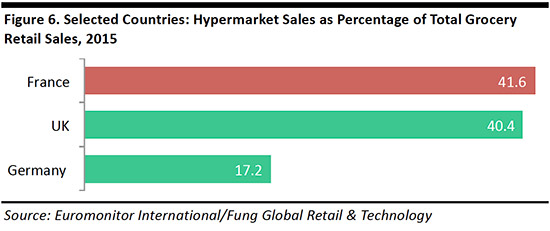
The prominence of the hypermarket format in French grocery retailing provided a fertile environment for the expansion of online grocery shopping and for click-and-drive:
- Hypermarkets are based on one-stop, big-basket shopping that offers convenience. A strong hypermarket sector favors the expansion of grocery e-commerce, because e-commerce offers a similar type of big-shop convenience that shoppers are used to.
- Hypermarkets have the outdoor space to offer drive-through collection points and the indoor capacity to be used as picking centers. Therefore, retailers that operate hypermarket formats can easily offer click-and-drive pickup service for groceries purchased online.
High-Frequency Shopping Encouraged Online Grocery Retailing Expansion, Despite Lower Penetration
The maturity and scale of the French online grocery market belies its limited consumer participation rate. According to May 2016 data from Mintel, a lower proportion of (Internet-connected) consumers buy groceries online in France than do in Poland or Spain—countries with far smaller online grocery markets.
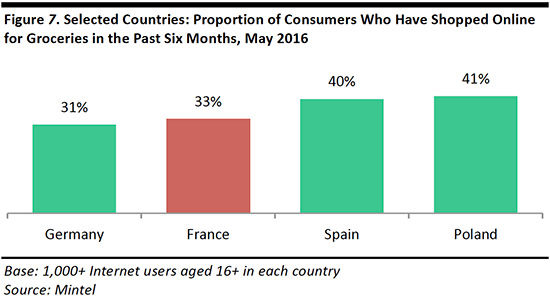
The explanation for this apparent contradiction lies in how frequently French consumers buy groceries online: online grocery shoppers in France simply buy groceries online more often than their counterparts do in markets such as the US. The data below show how France compares in terms of percentage of consumers who bought FMCGs online at least once in 2014 (penetration) and how many online orders were FMCG purchases in the same year (frequency).
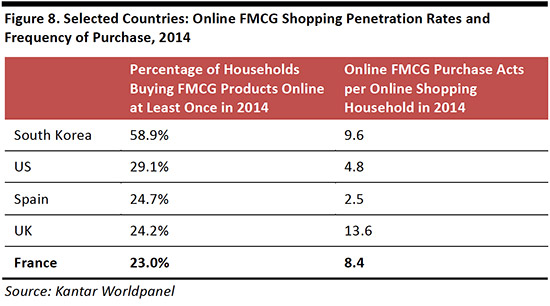
The differences in consumer behavior in the US and France have been encouraged by the different structures of their respective online grocery retailing sectors:
- In the US, online grocery shopping complements in-store grocery shopping. US consumers tend to buy specific grocery products on the Internet and tend not to perform large-basket shops online. As a result, US shoppers buy grocery products online only infrequently compared with shoppers in many other countries.
- In France, the segment of the consumer base buying groceries online (which is smaller than it is in the US) sees click-and-drive as a convenient alternative to in-store shopping. This means that French consumers who buy groceries online shop at roughly the same frequency as shoppers who buy only in-store (and that they shop more frequently than online grocery shoppers in US do).
We think the pioneering conduct of French brick-and-mortar retailers encouraged this different behavior among French consumers. While Amazon is the largest online grocery retailer in the US, in France, the sector is led by brick-and-mortar grocery retailers, with E.Leclerc holding the largest share. US consumers tend to buy only specific products on Amazon, and to buy the rest of their groceries in-store at the likes of Walmart. By contrast, French consumers buying online tend to simply do their regular grocery shopping on a brick-and-mortar retailer’s website and then go collect their order at the retailer’s drive-through collection point.
French Shoppers See Click-and-Drive as Saving Them Time and Money
Surveys suggest that French consumers value drive-through pickup service because it helps them save time and control their shopping budgets.
- Time sensitivity: French consumers appreciate the multi-channel model because it allows them to save time when shopping for groceries. According to Kantar Worldpanel, 68% of consumers polled in France claim to use click-and-drive because it saves time. The service presents a time-efficient way to shop for groceries that does not involve browsing large hypermarket outlets.
- Price sensitivity: French consumers also like the fact that shopping online for groceries helps them save money. According to Kantar Worldpanel, 34% of consumers polled in France use click-and-drive because it helps them control their budget. With online grocery shopping, shoppers can check the total order value of their shopping basket at any time. Also, online grocery shoppers tend to make fewer impulse purchases than in-store shoppers do, because they cannot see the physical products. In this sense, online grocery shopping can offer cost-saving benefits, particularly in a market such as France, where discounters have a relatively weaker presence than they do in Germany and the UK, where budget-conscious consumers tend to shop at discount retailers.
KEY TAKEAWAYS
These are our key takeaways on the French online grocery retailing market:
- France has one of the world’s leading online grocery markets. The share of grocery sales made online in France is one of the world’s largest. In Europe, only in the UK does e-commerce account for a larger share. The US and Germany lag France considerably in terms of e-commerce’s share of grocery sales.
- The early introduction of click-and-drive powered the expansion of online grocery retailing in France. Some French hypermarket retailers introduced click-and-drive in 2004. The early introduction of the service helped grow the market substantially at an early stage.
- Click-and-drive drove up online shopping frequency. Click-and-drive encouraged French consumers who buy groceries online to shop more frequently than consumers in other countries, as they see click-and-drive as a real and convenient alternative to in-store shopping.
Finally, we think the French market tells us something about the prospects for less mature online grocery markets, the US in particular. Click-and-drive is a model common to the French and US markets: in the US, Walmart and Kroger are rolling out collection points to more stores as they seek to play catchup with Amazon in online grocery. The French model suggests that these retailers will be able to build share and grow the online channel based on drive-through collection—largely because the model appears to encourage shoppers to regularly undertake large-basket shops online.
